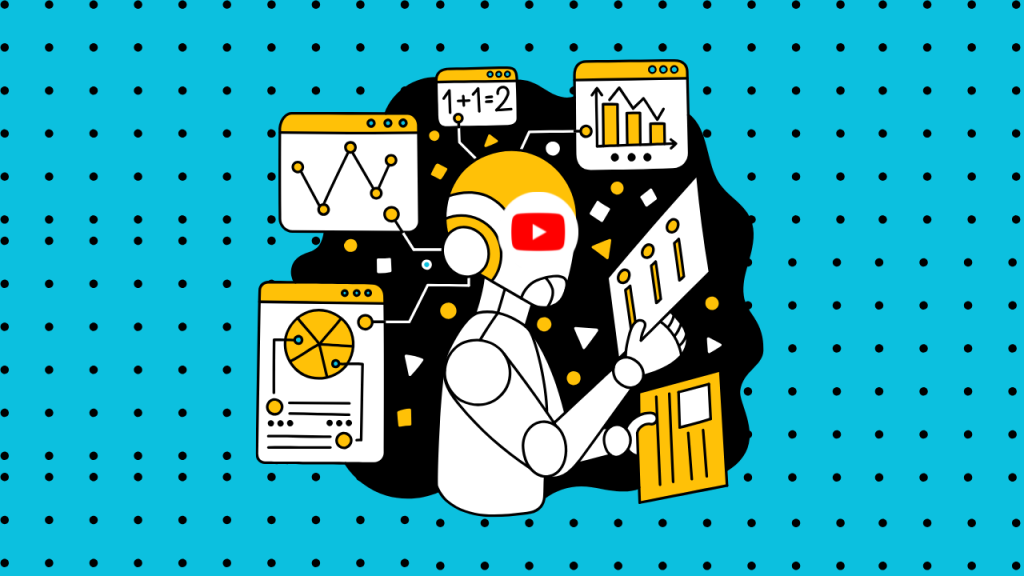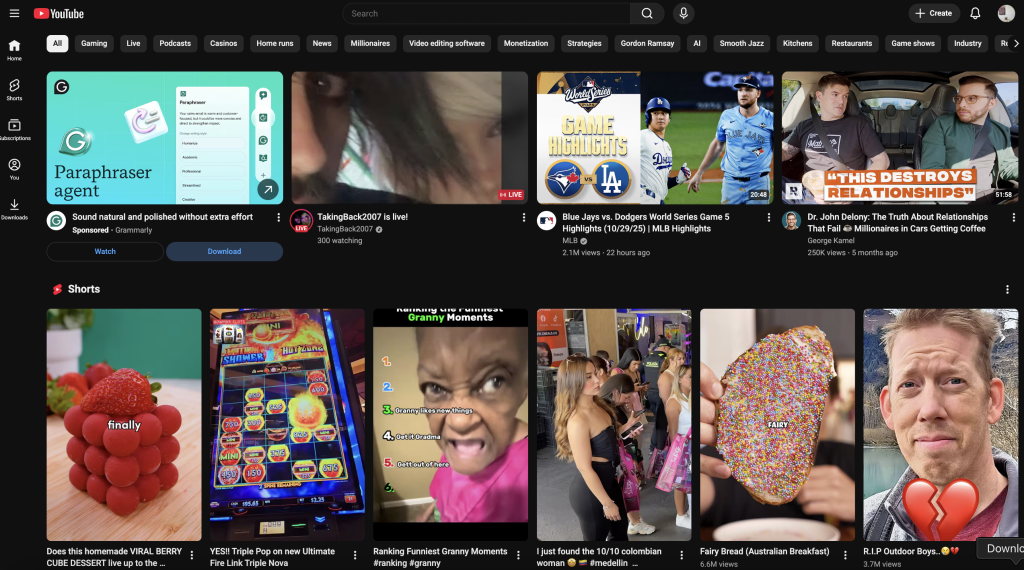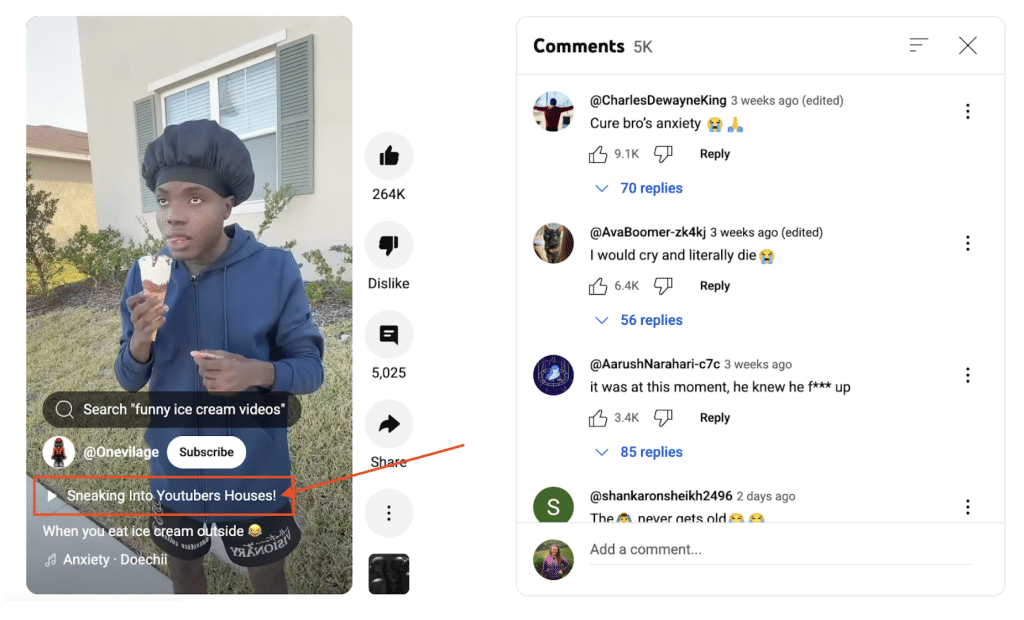Quick Answer
How does the YouTube algorithm work?
The YouTube algorithm analyzes viewer behavior to recommend videos that keep people watching longer.
It measures click-through rate, watch time, audience retention, and satisfaction signals to decide which content to promote on the homepage, suggested videos,
Shorts feed, and search. Videos that hold attention and lead viewers to watch more are pushed to larger audiences.
Introduction
If you’re using YouTube to grow your brand or business, understanding how the YouTube algorithm works is your biggest advantage.
The platform has billions of users, and the algorithm decides which videos they see. When you create content that YouTube wants to recommend, your reach, subscribers, and revenue can all skyrocket.
In 2025, YouTube’s algorithm has become smarter, more personalized, and more focused on viewer satisfaction than ever before.
This guide explains how the system works and what you can do to take full advantage of it.
Table of Contents
What is the YouTube algorithm?

The YouTube algorithm is an advanced AI ranking system that decides which videos appear on the homepage, in suggested recommendations, and in search results. Its primary goal is simple: keep people watching.
YouTube doesn’t just promote the most popular content. Instead, it promotes videos that are:
- Relevant to the viewer’s interests
- Likely to keep someone engaged longer
- Enjoyed by viewers with similar behavior
That means any creator can grow if their videos deliver a strong viewing experience. Let’s take a closer look at what role the algorithm plays in that.
How does the YouTube algorithm work in 2025?
The algorithm evaluates every viewer’s behavior: what they click, how long they stay, and how they interact. Then it customizes the platform to match that user’s taste.
YouTube doesn’t rely on one big algorithm but multiple algorithms working together, each responsible for a different discovery surface: Homepage, Suggested videos, Shorts feed, and Search.
Where your video performs best depends on:
- How compelling your thumbnail and title are
- How long viewers keep watching
- Whether viewers watch another video afterward
- Whether viewers interact and show they enjoyed the content
In short, YouTube wants your videos to start strong, retain attention, and lead viewers deeper into a watch session.
To answer the question how does the YouTube algorithm work, there are multiple factors to examine. Let’s begin with ranking signals.
Ranking signals that affect YouTube recommendations
To decide whether to recommend your video, YouTube measures signals such as:
- Click-through rate (do people click?)
- Watch time (do they stay?)
- Viewer retention (how long they stay?)
- Satisfaction (do they enjoy it?)
- Loyalty (do they come back?)
- Relevance (does your video match user interests?)
Forget outdated hacks– viewer satisfaction is one of the most important YouTube metrics in 2025. And all of the above signals help the YouTube algorithm figure out what viewers like.
If your videos keep people engaged, the algorithm will send more viewers your way. Let’s learn more about YouTube viewer satisfaction.
How does YouTube determine satisfaction?
The next step in learning how does the YouTube algorithm work is to understand what keeps viewers happy.
YouTube tracks both direct feedback and subtle behavioral clues to understand satisfaction.
Direct feedback includes likes, comments, shares, and survey ratings. Behavioral clues include replays, subscribing from a video, and watching more from the same channel.
If your content leaves viewers thinking, “I want more of this,” the algorithm takes notice. It does so through all of the ranking signals that we mentioned above.
It goes deeper than that, though. Here’s how satisfaction plays out across different recommendation surfaces:
Homepage recommendations

Your homepage includes videos YouTube predicts you will enjoy before you even search for anything.
These predictions come from viewing history, niche preferences, and engagement with certain channels.
If your video keeps early viewers watching, YouTube will continue testing it on more homepages, increasing exposure rapidly.
Suggested video recommendations
Suggested videos are the secret behind most viral moments.
They appear next to related content and autoplay after the current video ends.
If your topic, structure, and audience overlap with popular videos, your content can be pulled into the same recommendation ecosystem.
This often results in a domino effect: one successful video lifts multiple others.
YouTube Charts algorithm
Music and cultural content has its own ranking layer. Popularity here is influenced by:
- View volume and speed of engagement
- Social sharing
- User-generated uploads featuring the same track
For brands and artists, getting into this system creates massive momentum very quickly.
YouTube search algorithm
Because YouTube is a top global search engine, search traffic is incredibly valuable for long-term growth. Videos rank in search when they:
- Match user intent (keyword relevance)
- Deliver strong retention and engagement
- Receive positive viewer satisfaction
This is why how-to, tutorials, and educational videos perform exceptionally well. Viewers watch them longer and feel they gained value.
Negative feedback signals
If viewers abandon your video fast or report it as misleading, the algorithm stops promoting it. Clickbait that doesn’t deliver hurts your entire channel’s reputation in recommendation systems.
YouTube Shorts algorithm: How it works differently
YouTube Shorts are designed for fast discovery and viral potential. The Shorts algorithm focuses heavily on:
- Immediate hook strength
- Rewatch loops
- Swipe-away drop-off rate
- Like-to-view ratio
- Audience reaction (shares, comments)
Thumbnails and SEO matter less in Shorts; the video itself must grab attention instantly.
If a viewer watches all the way through and repeats the video, that’s a major positive signal.
Shorts also help introduce your channel to new viewers, who may then convert into loyal long-form watchers.

11 tips to improve your reach on YouTube
Here’s how to make the YouTube algorithm work for you instead of against you.
1. Stick to a consistent premise or format
One of the biggest growth mistakes beginners make on YouTube is creating random videos on every topic that interests them. Both the algorithm and your audience need clarity.
YouTube recommends videos when it knows exactly who they are for and when viewers can predict what they’ll get from your channel every time they click. This creates happy platform, happy user.
This doesn’t mean your content must be repetitive or boring. It means choosing a focused topic and delivering it through familiar formats that build trust with viewers.
Your premise should answer a simple question: Why should someone subscribe to you instead of just watching once?
To create consistency:
- Choose a YouTube niche that you can talk about endlessly (beauty, finance, gaming, food reviews, etc.)
- Develop repeatable video formats like tutorials, product reviews, challenges, or storytelling
- Maintain a recognizable style, such as humor, quick edits, voiceovers, or educational pacing
Example:
If your channel teaches digital marketing, jumping to vlog content or random lifestyle videos can confuse both the algorithm and your audience. But a consistent series like “Instagram Growth Case Studies” or “YouTube Tips Tested” helps viewers know exactly what value they’ll get when they return.
Consistency also influences how YouTube categorizes your channel.
When viewers who enjoy one video choose to watch another, that tells the platform your content satisfies a specific audience, making the algorithm more likely to recommend your videos to similar users.
Strong channels feel like clear brands. The more predictable your viewer experience, the faster YouTube learns who should see your videos, and the quicker your authority and reach will grow.
2. Feed the recommendation engine other sources
Don’t rely on YouTube alone to generate traffic. Promote new uploads on social channels, email newsletters, or collaborations.
That initial spike of interested viewers helps your video perform well in the crucial first few hours after posting.
Cross-posting is valuable not only for growth on YouTube, but for growing your brand reputation in general and creating more views across multiple networks.
3. Create clickable thumbnails

YouTube video thumbnails determine whether viewers give your video a chance. A great video can still flop if your thumbnail doesn’t convince someone to click.
Support your title by showing emotion, action, or storytelling visually.
Brand consistency also builds trust, and returning viewers will instantly recognize your content in a crowded feed.
4. Encourage viewers to stay after they click
Hook viewers in the first 5–10 seconds by clearly stating what they’re going to get. Remove slow intros, filler talk, and unnecessary branding.
Deliver value quickly and keep the pace high: retention helps the algorithm understand that your video is worth promoting.
5. Encourage binge watching on your channel
If one of your videos leads people to watch another one, YouTube will heavily reward that behavior.
Series-based content, playlists, strategic end screens, and verbal CTAs like “Watch this one next!” keep viewers in your ecosystem longer.
6. Optimize each video for a focus keyword
Write for real humans first, not bots, but make sure the YouTube algorithm can understand your topic.
Always consider human search intent and then consider what the YouTube algorithm might think of that.
A clear primary keyword in your title and description improves searchability and content relevance. When you speak the keyword in the video, captions reinforce what your content is about.
You can also use YouTube hashtags to be sure the algorithm knows how to categorize your video and for users to find you.
7. Keep an eye on your competitors
Studying similar creators helps you discover what audiences respond to. Look at which videos are gaining traction quickly.
Use that data to shape your own strategy while putting your unique angle on popular ideas.
8. Track metrics
YouTube analytics reveal patterns viewers may not express directly.

Consistently check where viewers drop off, which videos convert subscribers, and which topics bring new visitors.
The more data-informed your choices, the faster your channel grows. Then, the more you can monetize YouTube.
9. Create YouTube Shorts
YouTube Shorts expand reach to viewers who may have never discovered you otherwise. Even though the algorithm works a bit differently, it’s still an important feature for your channel.
They are a low-effort, high-reward content type that allows you to test topics and hooks quickly.
When Shorts perform well, viewers often explore your long-form content afterward.
YouTube Shorts was actually created to compete with Tiktok, and now both shorts and videos will appear for users and in the YouTube app.

It also allows you to link over to a longform video, which is a great feature for directing viewers to more vidoes.
Take advantage of this relatively new content style on YouTube to expand your content offerings and reach more users!
10. Post at optimal times
Publishing when your audience is active gives your video the strongest chance of early engagement.
Fresh engagement signals help videos get pushed to homepages and suggested feeds. Use YouTube Analytics to find peak times based on your unique audience.
Learning the best time to post on YouTube will help you to get seen right away, which will indicate to the YouTube algorithm that your content is popular among users.
Then, you’ll get more reach regularly.
11. Optimize for global audiences
YouTube is a worldwide platform.
Simple animations, universal humor, strong visuals, and captions allow anyone to engage with your content regardless of language.
The more accessible your videos are, the bigger your potential audience becomes.
In some cases, the audience may need to be more local; however, it’s much more viable as a long-term growth strategy to create content that can appeal to a global audience on the whole.
Use YouTube’s algorithm to grow your business
YouTube isn’t just a social platform: it’s a revenue engine.
The better you understand how YouTube recommends your videos, the easier it is to gain traffic that converts into leads and sales.
Long-form video builds authority, while Shorts build rapid awareness.
Together, they create a sustainable pipeline of viewers who enjoy your brand and return again and again. This is vital.
Instead of trying to beat the algorithm, learn how to align your content with what the platform values: audience attention and satisfaction.
YouTube algorithm FAQ
Here are the most common questions related to how does the YouTube algorithm work.
How does the algorithm of YouTube work?
It studies what each viewer watches, enjoys, and returns to. Then it recommends videos most likely to keep that person on the platform longer.
What is the 30 second rule on YouTube?
If a viewer watches at least 30 seconds, it signals strong interest. Videos that maintain attention early get promoted more.
Is there any trick to get views on YouTube?
There are no shortcuts. Growth comes from searchable topics, compelling thumbnails, retention-focused storytelling, and consistent uploads.
How many views do you need to make $1000 a month on YouTube?
Typically around 200,000–500,000 monthly views depending on niche, viewer location, and monetization options. Business-focused content usually earns more per view.
How does the YouTube algorithm determine video suggestions?
It looks for similarities in viewer behavior, not just video keywords. If fans of certain channels watch your video too, that’s a major recommendation trigger.
What triggers the YouTube algorithm?
High engagement, high retention, and positive satisfaction signals. YouTube pushes content that viewers watch fully, enjoy, and continue watching more afterward.
How can I increase my YouTube video views?
Deliver strong hooks, craft binge-worthy series, optimize for search, create Shorts, and engage with your audience daily.
Do dislikes affect YouTube’s algorithm?
Dislikes are considered feedback. They aren’t automatically negative — but if viewers leave quickly afterward, that hurts you far more.
How to go viral on YouTube’s algorithm?
Create content that solves a problem or entertains quickly, keeps attention high, and encourages watching multiple videos in a row.
How much money do you make per 1,000 views on YouTube?
Most creators earn between $1–$10 per 1,000 views depending on niche and advertising demand.



